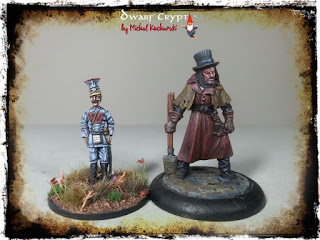[ENG/PL] World War I and Polish Legions / I wojna Światowa a Legiony Polskie (GreenMiniatures World War One / Pierwsza Wojna Światowa)
Today on DwarfCrypt a double novelty – a scale of peer-reviewed and painted figures that I have never seen before, and a historical period.
All thanks to Marcin from GreenMiniatures, who is one of the sculptors and originators of the battle system, which takes place during the First World War.
The scale of miniatures is 1:72 (20 mm) and the material is metal and to a lesser extent single resin models.
GreenMiniatures aims to popularize history using strategic games based on 20mm figures.
All models are hand-sculpt. In contrast to those produced using 3D technology, they have their own unique charm and strength.
I will write about the rules and gameplay after testing the system in future, focusing today on what big boys like the most, ie figurines.
An English Rulebook of World War One for free download will be prepared and will be available soon. Check download section
I received a few examples of models available so far for the parties to the conflict (Russian Empire, German Empire, Austra-Hungary), which I will gradually bring you closer.
Today it will be a figure of officer of the 1st Uhlan Regiment of Polish Legions, which was created from the inspiration placed in the entry of the photo.
The Polish Legions were brought to life on August 16, 1914 by the decision of the Supreme National Committee. Their formal basis for forming was the order of the Supreme Command of the Austro-Hungarian Army of August 27, 1914.
Initially, the ranks of the Legions were joined by members of all paramilitary organizations operating in the area of the Austrian Partition.
Polish Legions were organized as volunteer units, according to the instructions of the C.K. Army.
During the war of 1914-1918, a total of two legions brigades were formed – the First Brigade of Polish Legions and the Second Brigade of Polish Legions, known as the Carpathian or Iron. Polish Legions participated in many battles in the Great War.
GreenMiniatures stawia sobie za cel popularyzowanie historii za pomocą gier strategicznych opartych na figurkach w skali 20 mm.
Wszystkie modele są ręcznie rzeźbione. W odróżnieniu od tych produkowanych przy użyciu technologii 3D, posiadają swój wyjątkowy urok i siłę.
W trakcie wojny 1914-1918 powołano ogółem dwie brygady legionów – I Brygadę Legionów Polskich oraz II Brygadę Legionów Polskich, zwaną Karpacką lub Żelazną.
Dieser Artikel stammt von einer der angeschlossenen Quellen. Bitte honoriere die Arbeit der Autoren indem du ihren Webseite besuchst.
Artikelquelle besuchen
Autor: DwarfCryptDwarfCryptDwarfCrypt
Powered by WPeMatico









